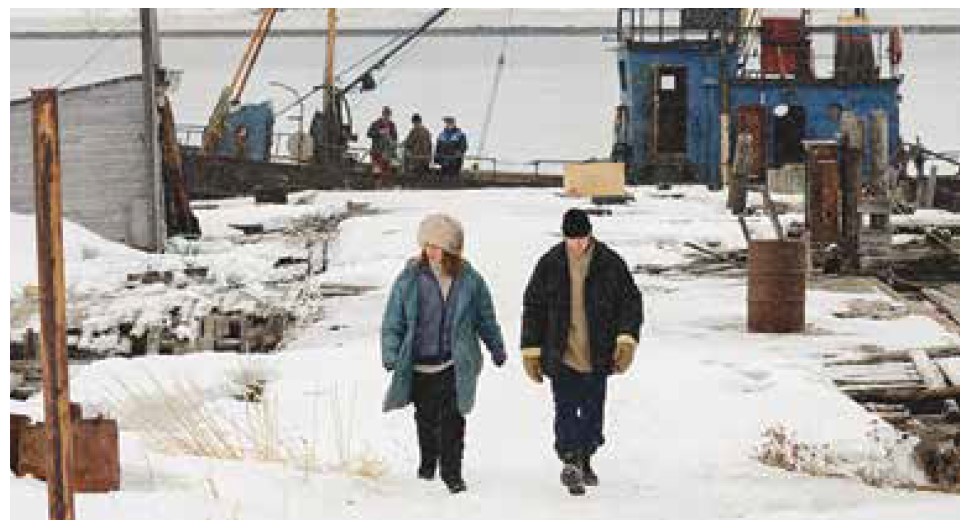
By Gary M. Kramer–
The title of a new film, Compartment No. 6, refers to the second-class berth on a train that travels from Moscow to Murmansk. It is a journey of several days, and Laura (Seidi Haarla) a Finnish grad student interested in archaeology, is headed to this arctic circle town to see the petroglyphs. To understand the present, she claims, she needs to know the past. (The film, which is now playing in the Bay Area, is set in the pre-Glasnost era.)
That idea may also be a metaphor for her personal life. She was supposed to make the trip with her girlfriend Irina (Dinara Drukravo), whom she was living with in Moscow, but Irina cancelled at the last minute. Laura is unhappy to be making journey alone—and even unhappier when her compartment mate on the train is Ljoha (Yuriy Borisov). The young Russian man, who is headed to the port city to work in mining, is drunk and verbally abusive when Laura first meets him. Laura tries to change compartments, but that is not possible. However, through a series of interactions, the two strangers come to a detente.

Compartment No. 6 is, thankfully, not an opposites-attract love story—Laura’s sexuality assures this—but it does show how these two lonely strangers on a train make an unexpected connection. Director Juho Kuosmanen—who cowrote the screenplay, an adaptation of Rosa Liksom’s novel—concentrates on the shifting balance of power between these two characters, and that is what makes his film so engrossing.

Laura is justifiably wary of Ljoha when they first meet, and she does not appreciate his boorish behavior. He challenges her perceptions, however, protecting her space when she leaves the compartment (with all her stuff) and asking her if she thinks he is a thief. Trust is also critical in Laura’s relationship with Ljoha when the train makes for an overnight stop. Arriving in a car that appears out of nowhere, Ljoha offers to take Laura on a ride out to see his friend Lidia (Lidia Kostina). Laura lacks a better option, and eventually joins him, leading to a sweet scene between the two women.
Laura is certainly distracted by her tenuous situation with Irina. Her girlfriend does not want to talk with Laura when she calls her at every train stop. The details of their relationship are vague, but Kuosmanen drops just enough clues in the early scenes of the women at a party, or in bed together, to indicate who has control. And much of the film involves Laura losing control to find herself and feel good again.
Laura gets frustrated when she tries to manipulate things to her advantage. When she meets Sasha (Tomi Alatalo), a Finn who boarded the train—and can’t communicate with the implacable conductor (Yuliya Aug)—Laura invites Sasha to stay in her compartment, despite his third-class ticket. It is a power move to upset Ljoha, and it does irritate him, but it also backfires on her. That said, it prompts Laura to give a very moving speech where she provides Ljoha with some context of her life.

The expected bond that develops between these characters provides Compartment No. 6” with its magic. The performances by Haarla and Borisov are so real that one might think they are non-professional actors. (They are not; both have numerous credits, though this is Haarla’s first lead in a feature, and she is particularly ingratiating.) They needle each other in ways that may seem to provoke, but in hindsight, reveal how they express themselves and communicate.
Ljoha has the same insecurities and fears as Laura does, but he internalizes them where she expresses hers. A terrific scene in a dining car on their last night together shows the dynamic of their relationship. Whereas Laura gives Ljoha a picture she secretly drew of him, and asks him to do the same, he denies her request. Whenever they try to find a level playing field, there is an imbalance.
Compartment No. 6 wisely extends the story beyond just the train ride, into Murmansk, and it is seeing how things play out with the characters that makes this film so emotionally satisfying.
Kuosmanen’s film is appropriately claustrophobic—the tight compartment on the train is, of course, a metaphor for the characters’ trapped emotions. In Murmansk, where scenes are shot in the vast, snowy outdoors, it is hard not to shiver at the cold. Viewers practically eavesdrop on the characters throughout the film, and the handheld camerawork creates a you-are-there feeling. The cramped spaces are so vivid that viewers can practically smell what is on screen, which is not a bad thing. The realism here is effective. Like the two central performances, everything feels lived in.
Ultimately, the film shows how these characters connect and grow as a result of knowing one another. In the process, viewers will likely feel that they too know these people, and will be glad that they spent quality time with them.
© 2022 Gary M. Kramer
Gary M. Kramer is the author of “Independent Queer Cinema: Reviews and Interviews,” and the co-editor of “Directory of World Cinema: Argentina.” Follow him on Twitter @garymkramer
Published on February 24, 2022
Recent Comments